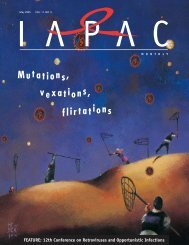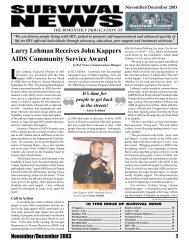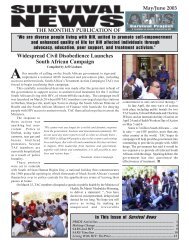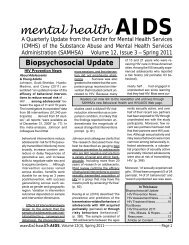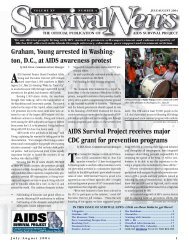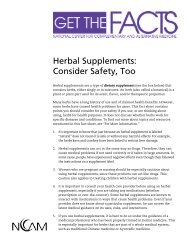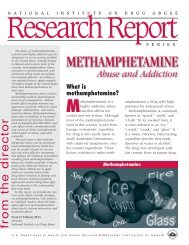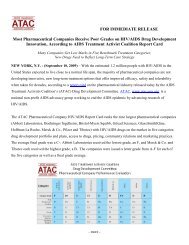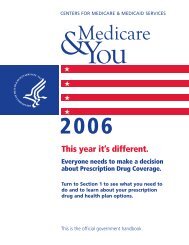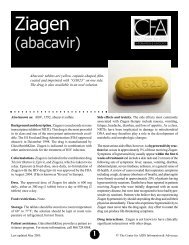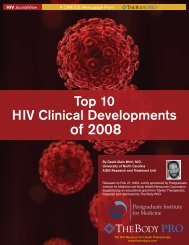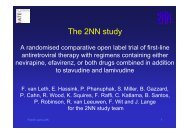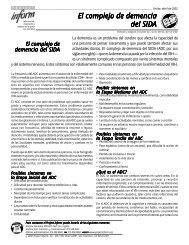HeAlTH INFormATioN & VieWs - CD8 T cells - The Body
HeAlTH INFormATioN & VieWs - CD8 T cells - The Body
HeAlTH INFormATioN & VieWs - CD8 T cells - The Body
You also want an ePaper? Increase the reach of your titles
YUMPU automatically turns print PDFs into web optimized ePapers that Google loves.
From<br />
Injection<br />
In the early 2000s, facial wasting—<br />
the loss of the fatty layer just under<br />
the skin on the face, particularly in<br />
the cheeks—was a real concern for<br />
people with HIV on anti-HIV therapy.<br />
With its signature sunken cheeks and<br />
resulting gaunt appearance, facial<br />
wasting can cause a lot of psychological<br />
and emotional distress. It can<br />
affect one’s self-esteem and it carries<br />
a huge social stigma because it pinpoints<br />
people as HIV positive. Needless<br />
to say, many people with HIV who<br />
were affected by it looked for ways to<br />
improve it.<br />
Facial wasting has been linked to the<br />
anti-HIV drugs d4T (stavudine, Zerit)<br />
and, to a lesser extent, AZT (zidovudine,<br />
also in Combivir and Trizivir). Fortunately,<br />
these drugs, especially d4T, are<br />
no longer commonly used in Canada<br />
now that other meds are available. As a<br />
result, facial wasting is much less of a<br />
problem today. Changing drugs was a<br />
way to stop the wasting but it usually<br />
didn’t reverse it.<br />
Facial fillers—synthetic polymers<br />
injected under the skin to replace the<br />
lost fat—was another option. One<br />
commonly used product was poly-Llactic<br />
acid (Sculptra). However, Sculptra<br />
is absorbed into the body after<br />
a few years and new implants are<br />
then needed. Another product used<br />
was polyalkylimide gel (Bio-Alcamid).<br />
Initially, it seemed that Bio-Alcamid<br />
A Canadian doctor advises<br />
people with HIV who have<br />
facial fillers to take extra<br />
care when having dental<br />
work done.<br />
was advantageous because, unlike<br />
Sculptra, it was a permanent implant<br />
and would not degrade. However,<br />
reports began to emerge from Western<br />
Europe of inflammation and infections<br />
in both HIV-positive and -negative<br />
people with Bio-Alcamid implants. As a<br />
result, several plastic surgery societies<br />
now discourage the use of Bio-Alcamid<br />
and other permanent implants.<br />
FiNDiNG iNFeCTioNs<br />
In 2005 Sculptra was not available<br />
in Canada—it would become available<br />
in late 2009—and Bio-Alcamid was still<br />
experimental. Dr. Mona Loutfy, an<br />
infectious disease specialist at the<br />
Maple Leaf Medical Clinic in Toronto,<br />
and her colleagues set up a study with<br />
36 participants to assess the permanent<br />
filler. <strong>The</strong> study was designed to<br />
last only two years; however, Dr. Loutfy<br />
began to notice infections and other<br />
complications in study participants and<br />
in other people with facial fillers. <strong>The</strong><br />
research team decided to extend the<br />
study to four years and now has plans<br />
to continue for a total of 10 years.<br />
In late 2011, the research team<br />
reported on the four-year study. It confirmed<br />
that the use of Bio-Alcamid can<br />
be associated with complications over<br />
to<br />
Infection<br />
the long term. Infection was one of the<br />
most common complications seen in<br />
the study. After an average of three<br />
years following injection, about one in<br />
four people had a confirmed or suspected<br />
infection in the face. In some<br />
cases, these infections were troublesome<br />
and required long-term treatment<br />
with antibiotics and surgery.<br />
tHe liNk To DeNTAl Work<br />
Interestingly, the researchers found<br />
that people with confirmed infections<br />
had had prior dental work. It is possible<br />
that this work, which included<br />
routine dental cleaning, may have<br />
damaged or contaminated the Bio-<br />
Alcamid implants with bacteria, leading<br />
to infections. As a result, Dr. Loutfy<br />
recommends: “HIV-positive people who<br />
have facial implants should always<br />
tell their dentists, hygienists and surgeons—any<br />
oral healthcare professional—about<br />
their implants prior to<br />
receiving any dental care.”<br />
She also has recommendations for<br />
oral healthcare professionals: Avoid<br />
injections into the upper gums leading<br />
into the cheek area, because they<br />
might puncture the implant and lead<br />
to infection. As well, she suggests that<br />
dentists offer their patients with facial<br />
fillers a broad-spectrum antibiotic one<br />
hour before dental work, including<br />
routine cleaning, to reduce the risk<br />
of infection. ✚<br />
Summer 2012 THE POSITIVE SIDE<br />
11



